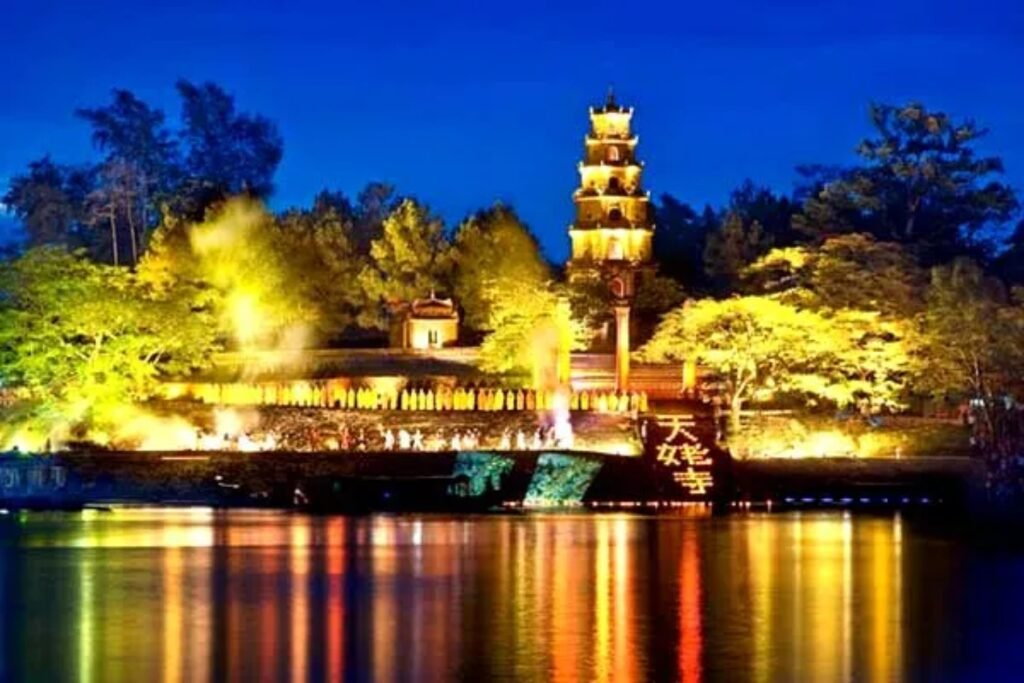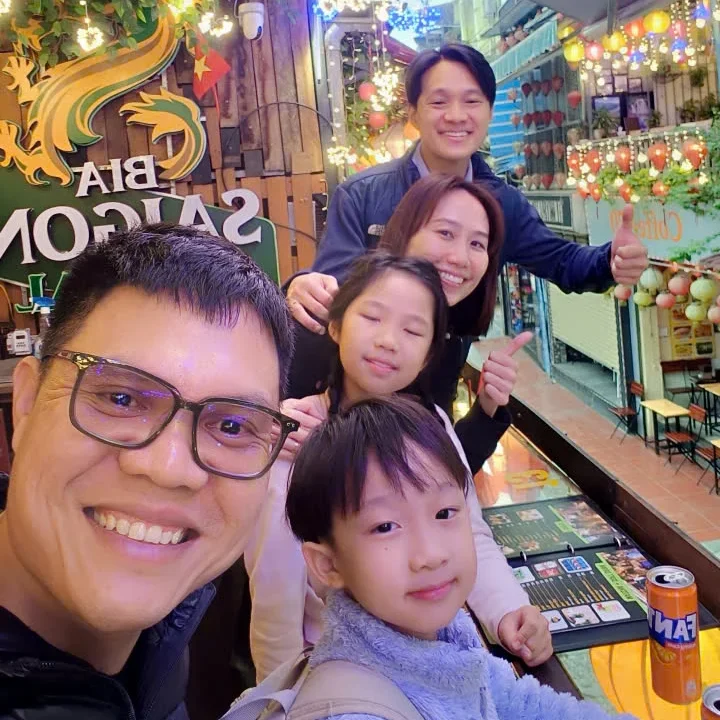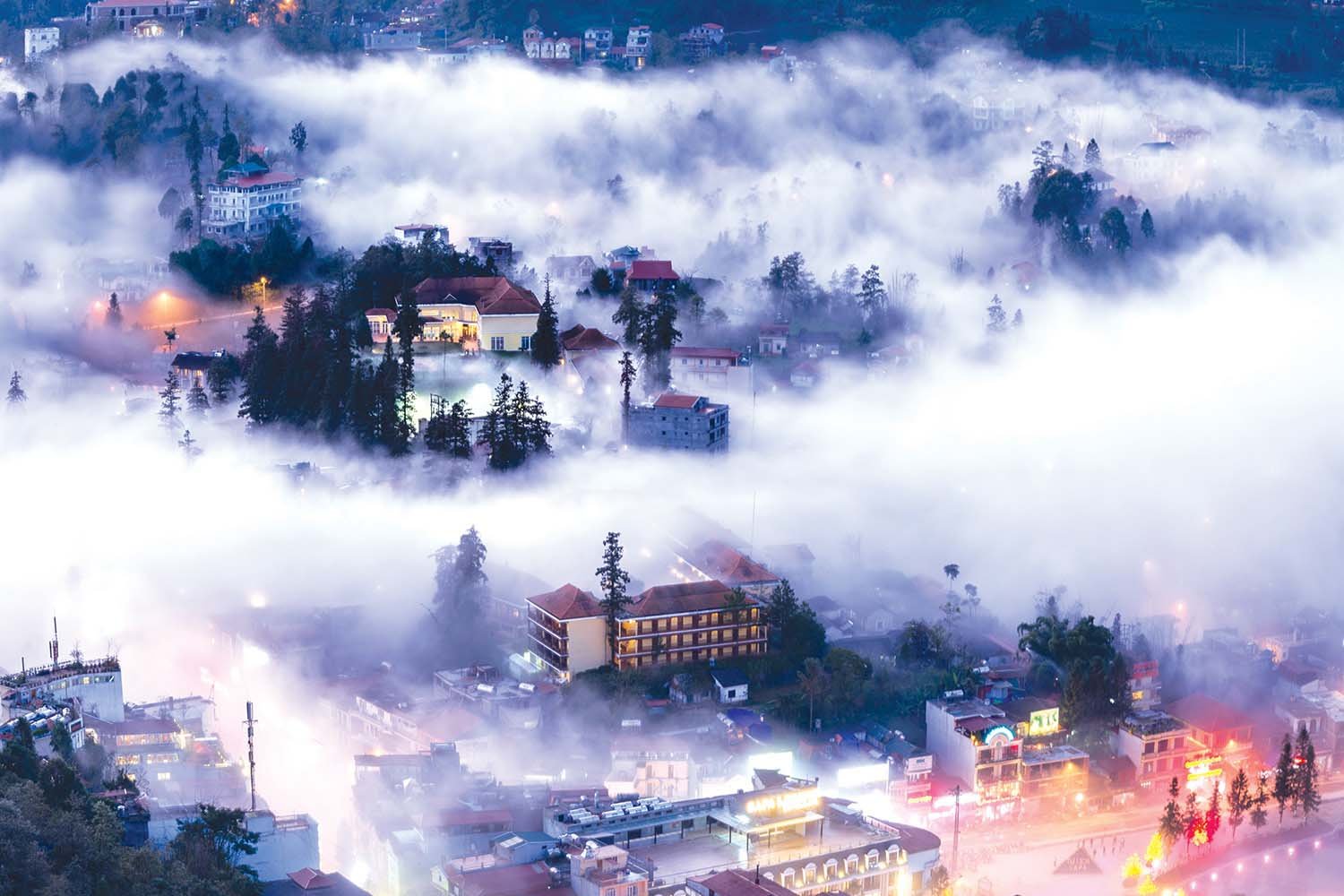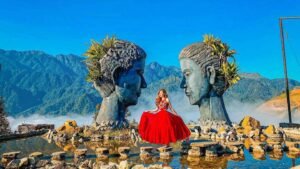Thien Mu Pagoda: Hue’s Iconic Seven-Story Pagoda & its History
 ngocdiem
ngocdiem Perched on the peaceful banks of the Perfume River, Thien Mu Pagoda is one of Hue’s most iconic landmarks. Its seven-story Phuoc Duyen Tower captivates visitors with its beauty, history, and spiritual significance. Built in 1601 under Lord Nguyen Hoang, the pagoda has witnessed Vietnam’s rich and turbulent history. Surrounded by lush greenery and serene views, Thien Mu Pagoda is a must-visit for those seeking history, culture, and tranquility.
1. Overview of Thien Mu Pagoda
1.1. Location
Thien Mu Pagoda is situated on Ha Khe Hill, along the north bank of the Hue Perfume River, approximately 5 kilometers west of Hue’s city center. Its elevated position offers breathtaking views of the peaceful river and surrounding landscape. This strategic location not only enhances the pagoda’s beauty but also plays a significant role in its spiritual importance. It’s easy to reach by motorbike, taxi, or a relaxing dragon boat ride along the river, making it a convenient stop for those exploring Hue.
1.2. Architecture
The most striking feature of Thien Mu Pagoda is the Phuoc Duyen Tower, a seven-story structure standing at 21 meters high. Built in 1844, the tower symbolizes different incarnations of Buddha and has become a defining symbol of Hue. Each floor is dedicated to a Buddha, representing the deep connection between architecture and Buddhist teachings.
Besides the tower, Hue pagoda boasts traditional Vietnamese temples architecture, with intricately designed shrines, ornate gates, and red-tiled roofs. The Dai Hung Shrine is the main sanctuary, housing precious Buddhist statues and relics, adding to the pagoda’s religious significance.
1.3. Serene Atmosphere
Surrounded by lush gardens and ancient bonsai trees, Thien Mu Pagoda offers a peaceful retreat from the hustle and bustle of the city. The tranquil setting, combined with the gentle sounds of chanting monks and the rustling leaves, creates an environment perfect for reflection and relaxation. Visitors often take their time wandering through the serene courtyards, soaking in the calm and spiritual energy that defines this iconic Hue pagoda.


🌟 Explore: Hue Ao Dai: Where to Rent and Get a Custom-Made One
2. Thien Mu Pagoda History
Origins
The history of Thien Mu Pagoda dates back to 1601 when it was built by Lord Nguyen Hoang, the first ruler of the Nguyen Dynasty in Central Vietnam. According to legend, Lord Nguyen Hoang was inspired to construct the pagoda after hearing a prophecy from a local elder about a “Heavenly Lady” (Thien Mu) who would appear and bless the land with prosperity. He believed the site on Ha Khe Hill was a sacred Hue pagoda and ordered the construction of the pagoda as a spiritual protector for the region.
Development
Over the centuries, Thien Mu Pagoda underwent several expansions and renovations under various Nguyen rulers. In 1710, Lord Nguyen Phuc Chu added the Great Bell, known as Dai Hong Chung, one of the largest bells in Vietnam, weighing over two tons. In 1844, Emperor Thieu Tri built the famous Phuoc Duyen Tower, further enhancing the pagoda’s prominence. Each addition and restoration reflected the Nguyen Dynasty’s devotion to Buddhism and their desire to leave a lasting cultural legacy.
Key Role in History
Beyond its religious significance, Thien Mu Pagoda history is intertwined with Vietnam’s turbulent past. The Hue pagoda served as a political and spiritual center during several important historical events. In the 1960s, it became a focal point for protests against the oppressive regime of President Ngo Dinh Diem. The image of Thich Quang Duc, a monk associated with the pagoda, who immolated himself in Saigon in 1963, became a powerful symbol of the Buddhist struggle for religious freedom.


👉 Explore: Exploring Hue Royal Tombs: A Glimpse into Dynastic Vietnam
3. Architectural Highlights of Thien Mu Pagoda
3.1. Phuoc Duyen Tower
The Phuoc Duyen Tower is undoubtedly the most recognizable feature of Thien Mu Pagoda. Standing 21 meters high with seven stories, it symbolizes the seven reincarnations of Buddha. Built in 1844 under Emperor Thieu Tri, the tower serves as a spiritual beacon and has become an iconic symbol of Hue. Each floor is dedicated to a different Buddha, reflecting the pagoda’s deep connection to Buddhist teachings. Visitors often stop to admire the tower’s symmetry and elegant design, which blends harmoniously with the surrounding landscape.
3.2. Dai Hung Shrine
The Dai Hung Shrine is the main sanctuary of Thien Mu Pagoda, housing several precious Buddhist statues and sacred relics. The shrine’s architecture is a blend of traditional Vietnamese style, with intricate carvings, red lacquered columns, and golden decorations. Inside, visitors will find impressive bronze statues of Buddha, as well as ancient artifacts that tell stories of Vietnam’s rich religious heritage. Dai Hung Shrine is a place of prayer and meditation, where monks and pilgrims gather for daily rituals.
3.3. Great Bell (Dai Hong Chung)
Another remarkable feature of Thien Mu Pagoda is the Great Bell, known as Dai Hong Chung. Cast in 1710, this massive bronze bell weighs over 2 tons and stands 2.5 meters tall. It is one of the largest bells in Vietnam, renowned for its deep, resonant sound that can be heard from miles away. Traditionally, the bell is rung during important ceremonies, its echo symbolizing a call for peace and spiritual awakening.
3.4. Gardens and Courtyards
Surrounding the main structures are beautifully landscaped gardens and courtyards that provide a tranquil setting for visitors. The lush greenery, ancient bonsai trees, and carefully maintained flower beds create a peaceful retreat for those seeking contemplation and relaxation. Stone pathways lead visitors through the grounds, offering moments of serenity and connection with nature. These green spaces are perfect for a leisurely walk, allowing visitors to absorb the spiritual energy of this historic Hue pagoda.
👉 Explore: The Definitive Hue Itinerary: 9 Must-Do Activities
4. Cultural and Religious Significance
Thien Mu Pagoda holds a significant place in Vietnam’s cultural and religious landscape. As one of the oldest and most revered pagodas in Central Vietnam, it serves as an important center for Buddhist practice and education. For centuries, it has been a sanctuary for monks and a spiritual haven for those seeking peace and enlightenment.


The Hue pagoda plays a crucial role in preserving Buddhist traditions and promoting spiritual values in the region. It is not just a place of worship but also a hub for Buddhist teachings, attracting monks and devotees from all over the country. Visitors can observe the daily rituals performed by the resident monks, who dedicate their lives to meditation, prayer, and service to the community.
Thien Mu Pagoda is a must-visit for both Buddhist pilgrims and cultural enthusiasts. Pilgrims often come here to pray for blessings and good fortune, believing that the spiritual energy of the Hue pagoda will bring peace to their lives. For history and culture lovers, the pagoda offers a glimpse into Vietnam’s past through its ancient architecture, sacred relics, and serene surroundings. The tranquil atmosphere and panoramic views of the Perfume River make it an unforgettable experience for all visitors.
👉 Explore: Experience the Magic of Hue Festival: Things to Do and See
5. How to Get to Thien Mu Pagoda
Reaching Thien Mu Pagoda is convenient, with several transportation options available. Depending on your preferences, you can choose from motorbikes, taxis, or even a scenic dragon boat ride along the Perfume River.
5.1. Transportation Options
- 📍 Motorbike: Renting a motorbike is a popular choice for those who enjoy the freedom to explore Hue at their own pace. It takes about 10–15 minutes to ride from the city center to the pagoda.
- 📍 Taxi: For a more comfortable journey, taxis are readily available in Hue. This option is suitable for families or those preferring a hassle-free trip.
- 📍 Dragon Boat: The most charming way to reach Thien Mu Pagoda is by taking a traditional dragon boat along the Perfume River. This leisurely cruise offers stunning views of the river and surrounding countryside, creating a memorable experience.
5.2. Best Time to Visit and Essential Travel Tips
The best time to visit Thien Mu Pagoda is during the dry season, from March to August, when the weather is warm and pleasant. Morning or late afternoon visits are recommended to avoid the midday heat.
- 📍 Tip 1: Bring a hat, sunscreen, and water to stay comfortable during your visit.
- 📍 Tip 2: Avoid weekends and holidays if you prefer a quieter, more peaceful experience.
- 📍 Tip 3: Keep your camera ready—there are plenty of photo opportunities, especially at sunset when the light over the Perfume River is magical.
🌟 For more information Hue and the latest updates, contact us via WhatsApp or visit the Sun Getaways Travel Fanpage, Tik Tok Or follow these posts to get the details if you want to:
6. Tips for Visiting Thien Mu Pagoda
To ensure a respectful and enjoyable visit, here are some important tips for exploring Thien Mu Pagoda:
Dress Code and Etiquette
- 📍 Modest Clothing: As a place of worship, visitors should wear appropriate attire. Avoid shorts, tank tops, and revealing clothing. Women are encouraged to wear long skirts or pants and cover their shoulders.
- 📍 Maintain Silence: The pagoda is a peaceful sanctuary for prayer and meditation. Keep noise to a minimum and respect the monks and other worshippers.
- 📍 Photography: While taking photos is allowed, refrain from photographing monks without their permission and avoid using flash in sacred areas.
Nearby Attractions
After visiting Thien Mu Pagoda, make the most of your trip by exploring other nearby historical sites:
- 📍 Hue Imperial City: A UNESCO World Heritage Site that was once the royal capital of Vietnam.
- 📍 Khai Dinh Tomb: An impressive royal mausoleum blending traditional Vietnamese and European architectural styles.
- 📍 Perfume River: Take a leisurely walk along the riverbank or enjoy another dragon boat ride to experience the beauty of Hue’s natural landscape.


👉 See more tour: 7 Days Best of Northern Vietnam
7. Conclusion
Thien Mu Pagoda is not just a historical landmark but a testament to the rich cultural and religious heritage of Hue. With its iconic seven-story Phuoc Duyen Tower, tranquil courtyards, and deep historical significance, the pagoda remains a must-visit destination for those seeking to connect with Vietnam’s past and spiritual traditions. From the stunning architecture to the peaceful surroundings along the Perfume River, every corner of the pagoda tells a story waiting to be discovered.
At Sun Getaways Travel, we are committed to offering unique experiences that help you explore the beauty of Vietnam’s heritage. A visit to Thien Mu Pagoda is the perfect way to immerse yourself in Hue’s history and culture. Let us help you plan your journey to this fascinating destination and create lasting memories of your time in Hue.
Ask a question
Leave a Comment (0)
No questions yet. Be the first to ask a question!





















